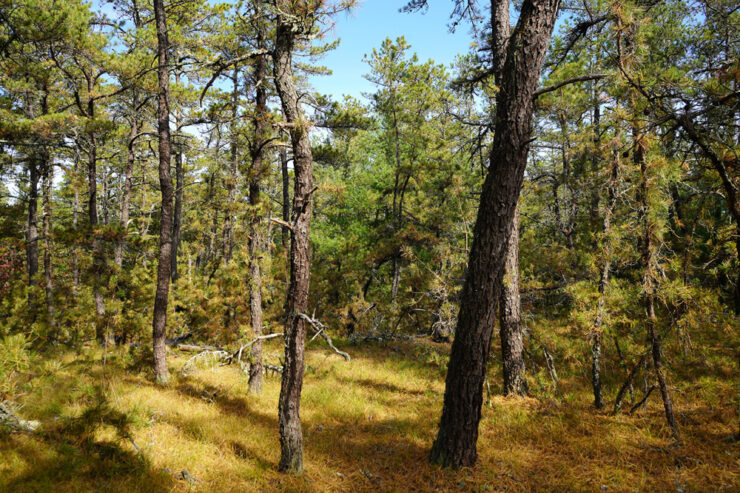Buying Tucker Woods Was A Good Land Deal
Those in Charlestown who oppose land conservation and the resulting protection of wildlife habitat, ground and surface water and other natural resources continue to misrepresent a good land deal for our town.
Acquiring a property that protects important natural resources at a price well below its retail value is a good deal for our town and a good use of funds dedicated to land conservation by the voters.
The Tucker Woods land was appraised at $915,000 in December 2020. On the basis of this appraisal, the state awarded Charlestown $400,000 towards the project, and the Town paid $500,000 in September 2021, for a total purchase price of $900,000.
The December 2020 appraisal, approved by the state, assumed that 22 lots would be developed and would sell for $125,000 to $135,000 each over 4 years, giving a retail value to the entire property of $2.8 million—clearly well in excess of the $900,000 paid. But in the time since the appraisal was done in December 2020, one-acre lots in northern Charlestown have sold for $150,000 to $240,000. Between the appraisal and the actual sale nearly a year later, the value of the land went up considerably, but the price did not.
For those who doubt the appraiser’s assumption of a 22-lot cluster subdivision, there was more than one way to develop this land. With 1,600 feet of frontage on Rt. 91, the landowner could have developed 9 frontage lots over a few years without the cost of building a town road. The value of those lots alone would have exceeded the price the town paid and would have left the landowner with over 50 acres to further subdivide.
For its $500,000, the town was able to preserve a property that is now worth well over $900,000 and at the same time achieves the following:
- Improves ground water quality within the recharge area of the Indian Cedar Swamp Groundwater Reservoir, a source of drinking water;
- Protects ponds and streams that are tributary to the nationally designated Wild and Scenic Pawcatuck River;
- Connects two large protected areas (the contiguous Francis Carter Preserve and the nearly contiguous Carolina Management Area) and fills a gap in the corridor of open space that extends from the Ninigret National Wildlife Refuge to the Carolina Wildlife Management Area in Richmond, and ultimately to the Massachusetts border;
- Protects state-identified rare species and critical habitats;
- Protects 1,600 feet of forest and prime farmland soils along a scenic rural state road (Alton Carolina Road);
- Provides public access to hiking and other passive recreation;
- Offsets the negative tax impacts of residential development.
For these reasons, preserving this important property was wholeheartedly supported by the Charlestown Citizens Alliance, The Nature Conservancy, the Wood Pawcatuck Watershed Association, the Wood Pawcatuck Wild and Scenic Rivers Stewardship Council, the Charlestown Land Trust, and many others. In addition, the state of Rhode Island fully supported the acquisition, committing state open space funds to the project.
The recent town-wide survey results show Charlestown citizens give the highest priority to protecting Charlestown’s environment and natural resources. They gave next highest priority to keeping taxes low. The preservation of Tucker Woods achieves both of those goals at once.

You can learn more about the author, Ruth Platner, at her profile page.
The banner image is a photo of a pitch pine barren that is part of the Tucker Woods property. Pitch pine barrens are state identified critical habitats that will provide a refuge for wildlife from climate change impacts and are high-priority candidates for protection and conservation efforts.

November 16, 2021 @ 9:03 pm
Thank you!!!
November 15, 2021 @ 3:59 pm
Just want to say Thankyou to those that had the vision to protect this space, from the owners who sold it to be protected and not developed, to the town for agreeing to it!
November 15, 2021 @ 12:30 pm
Keeping the culture of Charlestown should be a priority, along with the health of our watershed and environment. I had the privilege of walking Tucker Woods on Saturday with the Conservation Commission. It has an old farm path, streams, beautiful knolls and valleys. The future trail system will showcase these areas. The contiguous nature of this property to other protected lands will lend itself to a corridor for wildlife.
Thank you to all those working hard to protect the conservation values found in parcels like this.
With appreciation,
Karen Jarret
Charlestown Land Trust
August 2, 2022 @ 11:18 pm
Let’s not forget about the residents who were here first: Native American people and persons such as myself; my grandmothers last name was Peckham. Far too often individuals such as myself who have settled in this area since 1630 our under- represented or mid-represented by the board and so-called trustee members; just my two cents.
November 15, 2021 @ 10:30 am
100% agreed
November 13, 2021 @ 4:32 am
Thank you, Ruth.
This was a good deal. The more land that gets protected the better for Charlestown residents. They aren’t making any more land, so what we can preserve for public use of future generations is critical. Let’s keep Charlestown rural.